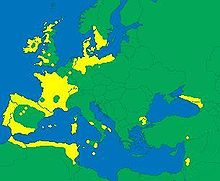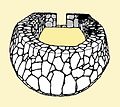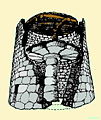Talayotic culture

The talayot culture was a prehistoric culture between the 13th and 2nd centuries BC. On the Balearic Islands in the western Mediterranean . It is known for the numerous remains of the eponymous tower buildings, the talayots , especially on Mallorca and Menorca . The cultural epoch on the islands was named after her Talayotic . The Talayot culture is a megalithic culture between the end of the Bronze Age and the beginning of the Iron Age , characterized by towers and other buildings in large stone construction .
Naming
The name talaiot ( Catalan ) and talayot ( Castilian ) is derived from the Catalan word talaia for "observation and watchtower", which has its origins in the Arabic atalaji for "guard". The archaeologist Joan Ramis from Menorca coined the term “Talayotic culture” from this.
history
On Mallorca, the larger settlements that can be found here and there are also called Clapers de Gegants (stone terrain of the giants). In Menorca, on the other hand, the classic talayots, as they are known from Mallorca (round or square), are relatively rare or have already decayed considerably due to the removal of stones ( Torre d'en Galmés ).
Similar structures were built in Corsica , Sardinia and Pantelleria during the Talayotic period . Some researchers therefore assume a connection between the cultures of the western Mediterranean at the time. The thesis that the Talayot culture emerged with the arrival of other peoples from the eastern Mediterranean on Mallorca and Menorca, who introduced the last section of the prehistory there with changed structures and a new social and economic system , has now been refuted. The culture of the Talayotic is a largely independent, understandable development of the Balearic Islands, whereby connections to other cultures are not excluded.
chronology
The age of the talayotic culture is divided into four sections (talayotic I to IV), covering the period from 1300 BC. Until the Roman conquest in 123 BC The first two or the last two of these periods of time show minor differences from one another. However, the talayotic culture is not a culture that emerged suddenly, but had its precursors, which are known as the pre-talayotic. The following table gives an overview of the historical sections known today of the cultural development of the islands up to the Romanization of the Balearic Islands.
| Culture section | Crafts and buildings | time | Synchronism |
|---|---|---|---|
| Pre-ceramic time | Machined flints and bones | 4000-2000 BC Chr. |
Sumerian culture , building pyramids in Egypt |
| Archaic pre-talayotic |
Unengraved and Engraved Ceramics; Living and burial sites in natural caves |
2000 - 1800 BC Chr. |
Early Bronze Age in Europe , Old Palace Age in Crete |
| The climax of the pre-talayotic |
Bronze tools, idol stones; first huts, burial sites also in artificial caves ( Cuevas ) |
1800 - 1500 BC Chr. |
Hyksos in Egypt , New Palace on Crete |
| End of the pre-talayotic |
Bronze arrowheads, "Talischer Götze"; Dwellings in megalithic navetas |
1500 - 1300 BC Chr. |
Iberian El Argar Culture , Middle Bronze Age in Europe |
| Talayotic I. | Bronze swords and other weapons; Solitary talayots, underground graves |
1300 - 1000 BC Chr. |
New Kingdom in Egypt , Mycenaean culture |
| Talayotic II | Walled fences are built | 1000 - 800 BC Chr. |
Late Bronze Age in Europe , Phoenician expansion |
| Talayotic III | Bull worship, cremation; Hypostylos halls, attached rooms with a rectangular floor plan |
800 - 500 BC Chr. |
Hallstatt Culture , Archaic Greece |
| Talayotic IV |
Acculturation , reproduction of ceramic forms, burial in fetus position (in lime); Sanctuaries |
500 - 123 BC Chr. |
Carthage trade republic , La Tène culture |
The time of Talayotic I , beginning around 1300 BC. Chr., Is characterized by the appearance of water reservoirs (sitjots), underground tombs and single towers in megalithic construction with Cyclops masonry . In Talayotic II , from approx. 1000 BC. BC, walled enclosures were added to the settlements. From these two sections of the first period of the Talayot culture up to about 800 BC. Finds of common pottery, burial pottery, bronze weapons and tools and worked bones are known.
In the section of Talayotic III there was already contact with seafaring cultures from outside the Balearic Islands, such as the Greeks and Phoenicians , then the Carthaginians . In the soil layers that were built in the years after 800 BC In addition to ceramics and figures made of bronze, objects made of lead and iron were also found . Various finds suggest a beginning trade with the Carthaginians , which began around 654 BC. Founded a trading post in Ibiza , Ebusim ( Ibis ). During this time the settlements received extensions with a rectangular floor plan as well as hypostylos halls (columned halls) and excavations made it possible to deduce a bull cult with cremation .
In Talayotic IV from around 500 BC. Chr. One went to the form of burial in fetus position (in lime ). Sanctuaries were built structurally and replicas of Carthaginian / Phoenician and Roman forms of ceramics emerged , which is known as acculturation . The offensive armament ( swords , knives , lance tips ) and the variety of tools increased in importance. The influence of other Mediterranean civilizations led to a gradual change in the local culture, which is evident not only from the household appliances found at the time, but also from the spiritual and artistic works, such as hero and warrior icons (small statues known under the name "Mars Balearicus").
In the first millennium BC Around-oval enclosures made of stone blocks appeared, enclosing some complexes. This wall was built around existing talayots. Examples are Capocorb Vell in the Llucmajor area , S'Illot near Sant Llorenç des Cardassar , Ses Païsses near Artà and Es Rossels in the Felanitx area . In addition, new architectural elements are appearing especially on Menorca. Columns and pilasters join together to form real hypostyloi, which in Menorca often represent a genus of their own built into the earth in the vicinity of the talayots and may be seen as the predecessors of the Menorcan taulen ( Torralba d'en Salord ). The Menorquins also erected some stone boxes, such as those at Alcaidús, Binidalinet, Montplè, Ses Roques Llises , Son Ferragut Nou and Son Ermità.
Prehistoric sites
Mallorca (by regions)
Palma
C'as Quitxero, Es Rafal, Son Sunyer
It pla
Binifat , Campanari des Moros, Cas Canar, Es Baulenes, Es Figueral de Son Real , Es Pou Celat, Es Pujolet, Es Racons, Es Turassot (pretalayotic), Es Velar de Maria, Necròpolis de Son Real , Sa Cova de sa Nineta , S'Illot des Porros , Son Bauló de Dalt , Son Coll Nou, Son Corró, Son Ferragut, Son Fornés , Son Fred , Son Homar, Son Marí, Son Perera Vell, Son Pou Vell, Son Serra de Marina, Son Vispó
Llevant
Bellver Ric, Ca n'Amer, Can Blai, Canyamel, Es Boc Vell, Llucamar, Mestre Ramon , Na Pol , Na Gatera, S'Illot , Puig Figuer , Pula , Sa Canova de Morell , Sa Gruta, Ses Païsses , S ' Heretat , S'Hospitalet Vell
Migjorn
Capocorb Vell (Capocorb d'en Jaquetó) , Es Antigors , Es Pedregar, Es Rossells, Es Velar de Son Herevet, Sa Talaia Grossa, Ses Talaies de Can Jordi, Son Danús Vell, Son Noguera
Raiguer
Es Picó, Can Peladet, Fideïcomis, S'Alcadena, S'Ermita, Son Sastre, Son Simó
Serra de Tramuntana
Alemany, Almallutx, Can Daniel Gran, Coma-sema, Coves de Sant Vicenç, Es Pujol, Les Arenes de Formentor, Llenaire, Pedret, Sa Roca Roja, Ses Casotes, Son Ferrandell, Son Gallard, Son Mas, Son Oleza, Son Puig , Puig de sa Morisca , Son Serralta
Menorca (by municipality)
Maó
Trepucó , Torelló, Talatí de Dalt , Sa Torreta, Binicalaf, Cornia Nou , Llucmaçanet Vell, Es Coster de s'Hort, Sa Cudia Cremada , Biniaiet Vell
Es Castell
Trebalúger, Binissaïda de sa Creueta
Es Migjorn Gran
Sant Agustí Vell , Binicodrell Darrera , Es Mestall
Ferreries
Son Mercer de Baix (with Cova des Moro), Binimassó , Binicalsitx
Sant Lluís
Biniparratxet Petit , Binissafullet
Alaior
Rafal Rubí , Biniac , Torralba d'en Salord , So na Caçana , Torre d'en Galmés , Na Comerma de Sa Garita , Torrellisar Vell , Son Rotger, Torralbenc Vell, Sant Vicenç d'Alcaidús , Na Patarrà
Ciutadella
Torrellafuda , Torretrencada , Naveta des Tudons , Son Catlar , Bellaventura, Son Bernardí, Torrevella d'en Lozano, Montefí
literature
Between 1869 and 1891 a nine-volume monumental work by the famous traveler Archduke Ludwig Salvator ( Lluís Salvador in Catalan ) was published in Leipzig . It is still reliable and accurate evidence of that era.
- Ludwig Salvator: The Balearic Islands. Described in words and pictures. 9 volumes. FA Brockhaus, Leipzig 1869-1891 (reprint of the edition: Woerl, Würzburg et al. 1897. MacMedia, Palma de Mallorca 2002, ISBN 84-932469-1-3 ).
- Luis Pericot: Las Islas Baleares en los tiempos prehistóricos . Ediciones Destino, Barcelona 1975, ISBN 84-233-0935-5 .
- Mark Van Strydonck: From Myotragus to Metellus - A journey into the prehistory and early history of Mallorca and Menorca . Librum, Hochwald 2014, ISBN 978-3-9524038-8-4 (Dutch: Monumentaal en mysterieus - Reis door de prehistorie van Mallorca en Menorca . Löwen 2002. Translated by Jürgen K. Schmidt).
Web links
- Talayotic culture (Spanish)
- Overview of localities ( Memento from September 30, 2007 in the Internet Archive ) (Spanish)
- Arqueobalear - Archaeological website of the Balearic Islands (Spanish)
Individual evidence
- ↑ a b Jaume Alzina i Mestre, Miquel Pastor Tous, Jaume Sureda Negre: The Talayot settlement of Ses Païsses. Ajuntament d'Artà, ISBN 84-606-2221-5 .
- ^ Heide Wetzel-Zollmann, Wolfgang Wetzel: Mallorca. A journey through the 6,000 year history of the Mediterranean island. Herder, Freiburg (Breisgau) a. a. 1991, ISBN 3-451-22311-2 , p. 14.












